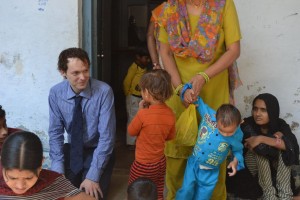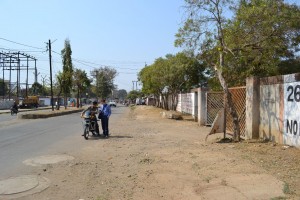I wanted to visit the site of the 1984 Union Carbide disaster. I also wanted to visit whatever major NGO was working with the survivors. This is why we went to Bhopal, the capitol of Madhya Pradesh.
I expected that affected people were still living in the area. I also expected that these people had been unable to work, and so would be dependent on financial support from whatever legal settlement had occurred. I had read that there were problems with the legal settlement because many people had not received any compensation. I expected the area to be in general poverty because of losing a generation of workers.
I was not expecting the area affected by the disaster to be among busy commercial and residential areas in a large capitol city like Bhopal, because I would not expect a chemical plant to be in such a place in any American city. But this chemical plant was not in a rural area; it was in good real estate in a major city.
I was not expecting that the chemical leak which happened in 1984 would be directly creating a third generation of victims today. I thought that one generation was poisoned and lost to productive lives, then future generations would merely be mired in poverty or possibly only the second generation would be born with birth defects due to their parents being poisoned. What I saw was that children continue to be born with birth defects because people continue to live in a poisoned area drinking poisoned well water and eating vegetables grown on poisoned ground. Since 1984 people have continually been living here and a large number of them start families here and a large number of children born here, if not all of them, are born with disabilities.Nandan and I went to four places all in the same neighborhood. We visited the Chingari Trust administrative office, the school managed by the trust, a site where the NGO is organizing a new office and school, and the site of the chemical spill itself.
At the school there were about 100 kids, most of them age 3-12. All of them had the physical appearance and social dispositions of people whose physical and mental disabilities would require them to remain in a state of lifelong dependence on others for the fulfillment of their daily needs. The teachers at the school said that the community demand was for 400 children to be enrolled in this school, and that they had to turn down the rest. The size of the school and the equipment and staffing made it seem appropriate to me for perhaps 30 children by American standards. The students who are admitted attend four hours a day for five days a week. The curriculum of the school is only life skills like reacting to social stimuli such as being spoken to and occupational therapy like standing or sitting. I am sure the school makes a huge difference in the lives of all its students because everything seemed masterfully organized when we dropped in unannounced and I know that the hard work of the counselors must be as effective as any counseling could be. Still, I cannot confidently say that I believe that a majority of the school’s graduates will be able to consistently recognize the sound of their own names or be able to walk across a room should they feel a desire to do so.
Nandan and I made some excellent contacts there. I hope that if we ever meet anyone who has the power to respond to this problem then we can connect them with the right people.
I think that there is a sense in the community that the chemical plant is continually responsible for the deformities in all these children being born and who will perpetually continue to be born. At this visit the most pressing question in my mind was why people continue to live in this area when it seems to me that almost any situation would be better than staying on poisoned earth. I have a societal bias in thinking that either the wasteland residents have some personal responsibility in preventing future damage or more probably the government has societal responsibility to forcibly evict everyone there and do whatever necessary to forbid anyone’s return. I got the sense that in their society the local people felt that someone external was responsible for their well being and that they were entirely victimized with no means by which they could have altered their fate.I can, however, understand the financial pressure against abandoning a large amount of central real estate in a major metropolitan center, and I suppose that people who live there have relatively cheap rent and better access to urban jobs and benefits.

